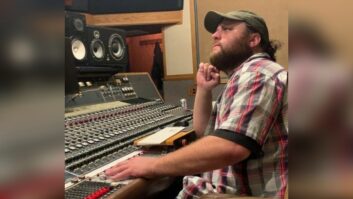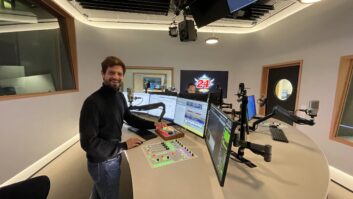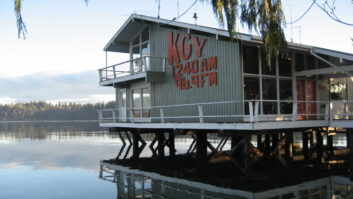“Gee, if only I could roll out of bed and be at work. Wouldn’t that be great?”
How many morning show hosts haven’t had that thought one time or another? No more waking up at 3 a.m., no more lunches at 10 o’clock when the local beanery around the corner is still serving breakfast, and no more 20-mile commute to the station. And no face time with the program director until it became absolutely necessary.
“If only I had my own home air studio,” the overwrought host would think, “I could hop out of bed just a half-hour before showtime, pull some prep material off the Net and crack the mic while still in my jammies. Now that’s living.”
In theory, I suppose. In practice, it might be an entirely new kind of animal with its own snags. No matter, I am about to find out as I undertake my latest why-on-earth-am-I-doing-this project: slamming together a home broadcast studio for the syndicated Greaseman show.
(click thumbnail)A Feng Shui nightmare: Al’s ‘Apartment of Doom’ in his Connecticut living room, circa 1991.
Ever so humble …
Throughout my own career, I have always had a home studio at my disposal for creating comedy routines and music bits. Some have been better than others, but none have ever been the way I wanted them.
The earliest one was in a spare upstairs bedroom in a Massachusetts farmhouse I rented during the early 1980s. A Tascam 234 four-track cassette deck, a Tascam 22-2 reel deck and an almost classic Teac 2A mixer, all mounted precariously in what used to be called a “computer desk;” a cheap, particle-board setup with a top-mounted hutch design that would draw guffaws today.
Affordable digital reverberation was still five years off, so I was obligated to use the reverb can in my old Fender guitar amp.
During quiet passages on my recordings, it was possible to hear squirrels chattering in the trees outside the window. The rig was nowhere near perfect, but it got the job done.
With a few additions, this ensemble followed me around the Northeast for a few years. Yamaha and Alesis processors displaced my old Fender, and a BSW Christmas clearance sale allowed me to purchase a Sennheiser 421, replacing an E-V “golf ball” mic I picked up at a music store some time prior.
The worst it got was the mess (Fig. 1) in my living room – yep, my living room – during my tenure at WLAD(AM) and WDAQ(FM) in Danbury, Conn.
Synthesizers from Casio, Yamaha, Moog and Roland were tripping over each other competing for space, a tangled homemade patchbay strung the mixer and decks together, and the whole aggregation was held up by homemade keyboard stands and equipment racks, fabricated from 2X2 lumber. In 1991, this was the Apartment of Doom.
All the while, one overriding desire burned within my heart: to finally be able to afford an eight-track reel-to-reel deck. Then I could do all the things I was hearing inside my head!
A funny thing happened along the way, though. By the time I could afford my precious reel deck, it was obsolete.
At WNNK(FM), Harrisburg, Pa., in 1994, I encountered the Roland DM line of digital recorders and realized the studio of my dreams needed a serious reevaluation. And when I heard that the original four-track version of SAW would run on a 386 PC, well, I just didn’t want that deck anymore.
Now, I have a room in my basement dedicated to my audio work. It is subject to HVAC noise and a pre-teen girl’s stereo upstairs. The air conditioner coolant pipes sound like a sluiceway during the summer and the gas jets on the furnace whistle like a leaky circus organ during the winter.
At least I have the gear I want. The rest will soon come my way.
Up and at ’em
But I digress.
While a domestic recording space has always been a dream, I never really wanted a home studio where I could do a live radio show. I preferred the company of coworkers and contest winners who “just wanted to wave through the glass.”
I liked having engineers nearby who could free up jammed tapes and replace the bulbs under the on/off buttons. I enjoyed the free-flowing cascade of promotional T-shirts, sport squeeze bottles and autographed guitars.
It is not just radio. I am not sure I have the discipline to fall out of bed, toss on a shirt and right away be at work in any occupation. If I were a fulltime free-lance writer like my Radio World buddy Ken R., I probably would not change out of my bathrobe at all the whole week. More power to him.
If I had a home broadcast studio, I would likely automate the first two hours of my show just to sleep late. And without input from my PD or from visitors, I would just as probably keep the same voice tracks loaded for eight months at a clip. Imagine being able to reliably set your watch each morning for a year by listening for the time I’d say, “Heyyy, g’mornin’ evvabuddy!”
Soldiers and firefighters are constantly on alert status and have to spring immediately to life out of REM sleep, so they are expected to fall out of bed and be at work. Probably a good reason I could not excel at either occupation.
I realized early on what an assault to the senses it was to wake up and instantly be on the job, back when I used to camp out at the radio station the night before a big snowstorm to assist with cancellation duties. It was quite a shock to the system to stagger off the couch in the jock lounge at 5 a.m., scratch the fuzz off my tongue and slam headlong into the news folks fielding phone calls, typing up the closings and running to the studios.
It was an even bigger shock to find out I was still in my briefs when I did that.
The House of Grease
So now I find myself with an interesting new task.
Doug “Greaseman” Tracht, about whom I wrote a few months back, is embarking on the next level of his emerging self-syndication efforts. To do that, he asked that a broadcast studio be carved out of some workspace in the basement of his suburban Washington home.
The decision was borne out of a number of reasons – first and foremost, expenses. Even the major broadcast corporations are watching the coinage these days, so small biz owners are even more conscientious. The cost of renting studio space at a local station for Tracht’s performance was beginning to chew on the bottom line. A home facility made more sense.
Second, technology. True, computerized audio is the way to go today, but a vast amount of the music, effects and vocal drops used on The Greaseman Show are still committed to cart. Rough estimates place his cart count at several thousand.
Interestingly, we encountered a small anomaly in time where used cart machines were momentarily less expensive than new computers! The purchase of two or three cart decks for the show is actually feasible.
We can still transfer lots of inventory to a PC or to the two Instant Replay units he owns, but Tracht still prefers media he can grab from a rack and hold in his hand.
Then there is the discipline that comes from 30 years of performance. Evidently, Greaseman can do what I cannot: fall out of bed and be ready for work.
Lastly, there is the single most advantageous aspect to owning your own broadcast studio: the chance to design it in a way that is strictly one’s own.
No more must a performer wrestle with a studio that impedes one’s performance. In spite of great strides made in cabinetry ergonomics and instant console reconfiguration, there will always be compromises.
A left-handed jock wants the touchscreen to be mounted on the left side of the console. Some engineering whiz-kid once demanded the bottom CD deck should be No. 1, while the top one is No. 3. The standup console is mounted too far back on the work surface to comfortably accommodate the five-foot-three midday talent.
Putting together your own studio is like the old Burger King spot: Have it your way. The touchscreen is this close, the mic pot is this pot, the cart deck is this far from the phone.
The trick is pulling it off inexpensively (remember “first and foremost” just a few paragraphs ago?). And who better to attempt this than the King of Cheap Studios: me.
Who spent a whole summer building a public access radio studio for free three years ago? Who has been working for The Greaseman for free for six months? Who was so frugal, he made a keyboard stand and gear rack out of 2X2s rather than drop a whopping 80 bucks to purchase the same? Hint: Refer back to Fig. 1.
So, will I do it for a modest buck? Yeah, I’ll do it. Maybe I’ll get some ideas for how I want my own studio to be. I’ll keep you apprised.













